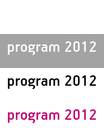| poprzedni | lista | następny |
|
Gazeta Festiwalowa "Na horyzoncie", nr 9
26 lipca 2012
Sound and Vision
In the postscript of Philippe Grandrieux's impressive cine-portrait 'It May Be That Beauty Has Strengthened Our Resolve: Masao Adachi', the Japanese director identifies the process of filmmaking as a shift between idea and sensation. Adachi is not alone in emphasising this journey from concept to completed project; it is clearly apparent in the work of Marina Abramović and James Benning. Matthew Akers' 'Marina Abramović: The Artist is Present' begins as a conventional portrait of the Serbian performance artist's life and work, and her preparations for a forthcoming retrospective at New York's Museum of Modern Art. The centrepiece will be a new and challenging work. From 14 March to 31 May 2010, Abramović sat on a seat in an open space for 7 hours a day, looking at whoever chose to sit in the seat opposite her. A table was initially placed between the chairs, but this was removed during the run in order to free up the physical and emotional space between the two subjects. Aside of the gruelling physical regimen involved in such inactivity, reactions to the work proved to be surprising. From a simple idea of slowing down time, allowing people whose lives are lived in a rush the opportunity to reflect in silence, Abramović created a work in which the sitters saw in the artist's face their own hopes or fears reflected back at them. Akers perfectly captures the transformation of an interesting concept into a moving portrait of an artist who has found a way to engage on a purely emotional level. James Benning is arguably the best American director that very few people have heard of. His films rarely travel beyond festivals and retrospectives. Most are comprised of long shots of landscapes, wild, rural, urban and industrial, that vary in length from a few seconds to 90 minutes. With the exception of his 2010 film 'Ruhr', all his work has been filmed in North America. Two of Benning's films are screening in the festival. 'Small Roads' is the most familiar. A series of shots of smaller roads across 15 US states, each around 2 minutes long, it can be seen as a companion piece to 2007's 'RR', in which the duration of individual shots corresponded to the time it took for a railway locomotive to pass across the frame. There is no narrative as such here, although the film appear to move through the seasons, from spring to the depths of winter. What becomes clear, through the culmination of images, is the way that nature and mankind are constantly vying for these spaces. Benning's most radical project yet is inspired by Henry David Thoreau's 'Walden' and the manifesto of Theodore John 'Ted' Kaczynski, the Unabomber. Benning built two replicas of the men's rural retreats near his own home in the Sierra Nevadas. Images of the reconstructions appear in the book 'Two Cabins'. Alongside these are three films. 'Nightfall' is one of them. With it, Benning pushes his minimalist approach to its limit, creating a 90-minute, single-shot work. We witness a wooded area at the end of the day, as light gives way to dusk and, finally, complete darkness. It is his most painterly film to date, with moments resembling an Anslem Kiefer canvass. Some might balk at the idea of watching one image, no matter how beautifully framed, for such a length of time. But the image is only one of the elements essential to Benning's work. Sound is equally important. And together they transform Benning's ideas into something truly unique. |
Moje NH
Strona archiwalna 12. edycji (2012 rok)
Przejdź do strony aktualnej edycji festiwalu:
www.nowehoryzonty.pl Nawigator
Lipiec 2012
Szukaj
filmu / reżysera / koncertu
|



















